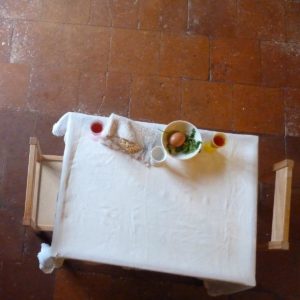
Why would you celebrate Passover if you’re not Jewish? Such a good question!
We’ve been celebrating Passover for over ten years now. Our children have grown up in a home where it’s the norm and each year we’ve invited other people to join us. In some ways, we celebrate Passover because we celebrate a weekly Shabbat. In fact in the Bible, the lists of all the ‘big’ festivals like Passover are prefaced with instru;;ctions to observe a Sabbath, or Shabbat. For me, Passover is like a Mega-Sabbath, or maybe Shabbat is a mini-Passover. Anyway, I thought I’d share some of the ways our faith at home has benefitted from ‘doing’ Passover, as I think it’s something you might enjoy and benefit from as a family.
Stories
Stories are such an important part of our faith. They are so powerful! In the run up to Passover, we read or listen to the whole Exodus and Easter stories from the Bible. It’s a great way to make Bible stories part of our regular faith at home life. Remembering where we have come from is so important to the development of our identity, and as Christians remembering the ancient stories of God’s people helps ground us in the memories and experience of the people into which we are ‘grafted’.
Exploring the ancient stories about God’s people enables us to connect our story to the much bigger, wider, older story of God’s people through the ages. As we explore the Exodus story, we discover themes, such as slavery and freedom, a theme still very important for us as individuals, communities and nations. The process of being set free, of leaving behind a place of hardship and entering into an unknown is one which really resonates with me this year. Previously, it was the theme of passing through water which I felt reflected where we were at as a family. Each year it’s the same story, but as always with the Bible, there are always new ways to connect with it. By exploring the same story each year, we go deeper each time.
Connections
As a Christian celebrating Passover, the Exodus story has obvious links with the Easter story. Each year I read a little bit about Passover, the traditions around it, the context of the original story, and sometimes I research a little bit of Hebrew used as prayers or blessings in the Passover seder. I find this brings new depth and richness each year as I discover new resonances with the story of Jesus. For example, during Passover there are three pieces of matzah or flat bread. Traditionally there would usually be two pieces of bread at a weekly Sabbath meal, and the extra piece used on Passover represents the lamb which used to be sacrificed in the temple at Passover. This piece may have been the one Jesus broke and said, “This is my body, broken for you.” Wow!
Last year I discovered that in Jesus’ day it is believe that the sacrificial lambs were killed in the temple in such a way that they looked a lot like they were on a cross. Each time I research Passover, I discover more.
Most people believe that Jesus celebrated Passover on the night He was betrayed, and so Easter and Passover are intricately linked, although they don’t always coincide. Our family celebrates Passover on Good Friday and this is our way to bring the two stories together. We celebrate Shabbat each Friday and so it makes sense for us to do Passover on a Friday too.
Symbols
Passover is a great way to explore using symbols in our faith at home. As I’ve research Passover, I’m always finding new meanings which people have attributed to the Passover elements. The two candles represent different things, as do the four glasses wine, and of course the different foods on the seder plate. Even the symbols differ – not every seder plate is the same! While some Christian traditions use symbols as part of their church services, fewer families use symbols in their faith at home together. Symbols are a powerful way to build connections between the visible, physical world and the invisible spiritual world of faith. While you may not want to use the symbols in the exact way another family does, you might find some symbols which are particularly pertinent for your family or be inspired to create your own.
Joy and sorrow
One part of the Passover tradition which I love is the acknowledgement of both joy and sorrow. This stems from the Exodus story, where even as the plagues paved the way for Pharaoh telling the Israelites to leave Egypt, the effect of the plagues, especially the last one, had a devastating effect on the Egyptian people. Our seder, or service, says that “life is full of bitter endings and sweet new beginnings”, and to mark this juxtaposition we eat a pair of foods which are bitter and sweet. This pairing is done twice, just in case we miss it the first time. I found this especially helpful during Passover when we were waiting to conceive our first daughter. I’m always reminded at celebrations how difficult they are for anyone who has lost someone they love, and this part of Passover allows us to share our joys and sorrows together.
Shared experience
Passover is a great way to come together as a family, and to share a celebration with other families. Having rituals like Passover helps us reflect, remember and be thankful. They help us find meaning, and grow, and they allow us to find connections between our current experience and our past and our future.
A ritual like Passover helps us see outside our own small group. One of the things I love about Passover and freedom for oppressed people, many Jews have added food to the seder plate to represent group of people they care about who are oppressed right now. The struggle for freedom and justice is brought up to date using something delicious on their plate. It’s good to remember people outside our own circle who are struggling for their own freedom today.
Food!
One reason to celebrate Passover even if you’re not Jewish is if you like food. Michele Guiness says all Jewish festivals have food as a vital element. As someone who likes cooking and eating, I love exploring different recipes and traditions of what people make for Passover. There’s so many different traditions and recipes, usually more than I have time to try out each year. And of course, there are some things which end up being part of the tradition we keep, and have to be made each year. One website I’d recommend for this is ToryAvey.com
As a Christian Passover helps give me so much context for the Easter story which I never knew before. The ritual enables us as a family to share in the meal Jesus shared with His friends and to allow the depth of meaning to grow year on year.
If you’d like to try out a bit of a Passover celebration this year you can download our family seder here and you might like to join me for my Online Passover Workshop, which is very flexible and can be done at a time and to the extent it works for you. See more details on that here.
Looking for a fun, easy Easter activity? These Easter puppets are simple to make and you'll have fun telling the story together using the storyboard. Available as a book or a download
